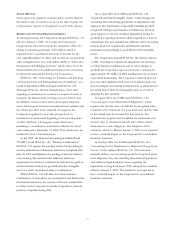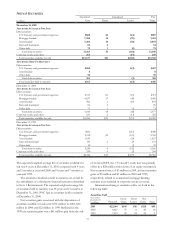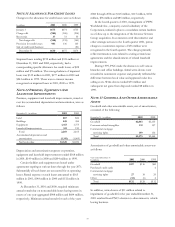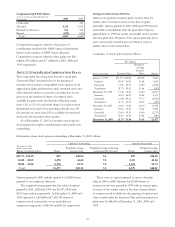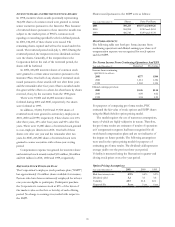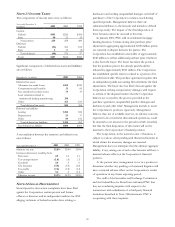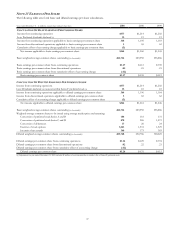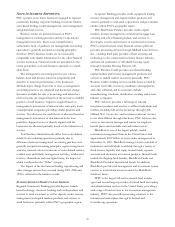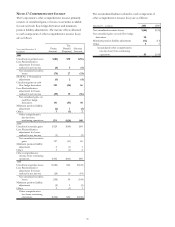PNC Bank 2001 Annual Report Download - page 83
Download and view the complete annual report
Please find page 83 of the 2001 PNC Bank annual report below. You can navigate through the pages in the report by either clicking on the pages listed below, or by using the keyword search tool below to find specific information within the annual report.
81
The following table sets forth regulatory capital ratios for
PNC and its only significant bank subsidiary, PNC Bank,
N.A.:
Regulatory Capital
Amount Ratios
December 31
Dollars in millions 2001 2000 2001 2000
Risk-based capital
Tier I
PNC $4,599 $5,367 7.8% 8.6%
PNC Bank, N.A. 4,704 5,055 8.7 8.7
Total
PNC 6,958 7,845 11.8 12.6
PNC Bank, N.A. 6,581 7,012 12.1 12.1
Leverage
PNC 4,599 5,367 6.8 8.0
PNC Bank, N.A. 4,704 5,055 7.6 8.2
The access to and cost of funding new business initiatives
including acquisitions, the ability to pay dividends, deposit
insurance costs, and the level and nature of regulatory
oversight depend, in large part, on a financial institution’s
capital strength. The minimum regulatory capital ratios are
4% for Tier I risk-based, 8% for total risk-based and 3% for
leverage. However, regulators may require higher capital
levels when particular circumstances warrant. To qualify as
“well capitalized,” regulators require banks to maintain
capital ratios of at least 6% for Tier I risk-based, 10% for
total risk-based and 5% for leverage. At December 31, 2001,
the Corporation and each bank subsidiary met the “well
capitalized” capital ratio requirements.
The principal source of parent company revenue and
cash flow is the dividends it receives from PNC Bank. The
bank’s dividend level may be impacted by its capital needs,
supervisory policies, corporate policies, contractual
restrictions and other factors. Also, there are legal limitations
on the ability of national banks to pay dividends or make
other capital distributions. PNC Bank was not permitted to
pay dividends to the parent company as of December 31,
2001 without prior approval from banking regulators as a
result of the repositioning charges taken in 2001 and prior
dividends. Under these limitations, PNC Bank’s capacity to
pay dividends without prior regulatory approval can be
restored through retention of earnings. Management expects
PNC Bank’s dividend capacity relative to such legal
limitations to be restored during 2002 from retained
earnings. The parent company currently has available funds
to pay dividends at current rates through 2002.
Under federal law, bank subsidiaries generally may not
extend credit to the parent company or its nonbank
subsidiaries on terms and under circumstances that are not
substantially the same as comparable extensions of credit to
nonaffiliates. No extension of credit may be made to the
parent company or a nonbank subsidiary which is in excess
of 10% of the capital stock and surplus of such bank
subsidiary or in excess of 20% of the capital and surplus of
such bank subsidiary as to aggregate extensions of credit to
the parent company and its subsidiaries. Such extensions of
credit, with limited exceptions, must be fully collateralized by
certain specified assets. In certain circumstances, federal
regulatory authorities may impose more restrictive
limitations.
Federal Reserve Board regulations require depository
institutions to maintain cash reserves with the Federal
Reserve Bank. During 2001, subsidiary banks maintained
reserves which averaged $127 million.
NOTE 20 FINANCIAL DERIVATIVES
Effective January 1, 2001, the Corporation implemented
SFAS No. 133. As a result of the adoption of this statement,
the Corporation recognized, in the first quarter of 2001, an
after-tax loss from the cumulative effect of a change in
accounting principle of $5 million reported in the
consolidated income statement and an after-tax accumulated
other comprehensive loss of $4 million. The impact of the
adoption of this standard related to the residential mortgage
banking business is reflected in the results of discontinued
operations.
Earnings adjustments resulting from cash flow and fair
value hedge ineffectiveness were not significant to the results
of operations of the Corporation during 2001.
During the next twelve months, the Corporation expects
to reclassify to earnings $118 million of pretax net gains, or
$77 million after tax, on cash flow hedge derivatives
currently reported in accumulated other comprehensive
income. These net gains are anticipated to result from net
cash flows on receive fixed interest rate swaps and would
mitigate reductions in interest income recognized on the
related floating rate commercial loans.
The Corporation generally has established agreements
with its major derivative dealer counterparties that provide
for exchanges of marketable securities or cash to collateralize
either party’s positions. At December 31, 2001 the
Corporation held cash and U.S. government securities with a
fair value of $190 million to collateralize net gains with
counterparties.
At December 31, 2000, the Corporation had financial
derivatives used for risk management with notional amounts
totaling $15.7 billion. These derivatives had a net positive fair


